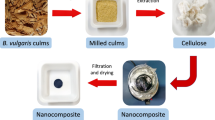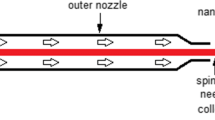Abstract
Self-doped polyaniline/cellulose fibers (SPANI/CF) hybrid was in situ prepared by copolymerization of aniline and metanilic acid in presence of cellulose fibers to improve its dedoping-resistant ability. The results indicated that the SPANI/CF hybrid was remarkably more resistant to dedoping by alkaline aqueous solution than the polyaniline/cellulose fibers (PANI/CF) hybrid. Self-doping did not increase the electrical conductivity of the hybrid, but increased its flame retardancy. Both the electrical conductivity and oxygen index of the SPANI/CF hybrid decreased after ammonia soaking treatment, and the color changed gradually from green to bluish violet with increase of the ammonia concentration. The original (non-dedoped) and dedoped SPANI/CF and PANI/CF hybrids were characterized by attenuated total reflection (ATR) Fourier-transform infrared (FTIR) spectroscopy, X-ray photoelectron spectroscopy (XPS), and scanning electron microscopy (SEM) analyses, revealing the occurrence of deprotonation during ammonia soaking treatment. Compared with the PANI/CF hybrid, additional ring substitution with sulfo groups was probably responsible for the significantly better dedoping-resistant ability of the SPANI/CF hybrid.






Similar content being viewed by others
References
Bergeron JY, Jean-Wilbert Chevalier JW, Dao LH (1990) Water-soluble conducting poly(aniline) polymer. J Chem Soc, Chem Commun 2:180–182
Chen Y, Qian X, An X (2011) Preparation and characterization of conductive paper via in situ polymerization of 3,4-ethylenedioxythiophene. BioRes 6(3):3410–3423
Ding C, Qian X, Shen J, An X (2010a) Preparation and characterization of conductive paper via in situ polymerization of pyrrole. BioRes 5(1):303–315
Ding C, Qian X, Yu G, An X (2010b) Dopant effect and characterization of polypyrrole–cellulose composites prepared by in situ polymerization process. Cellulose 17(6):1067–1077
Goto H (2011) Electrically conducting paper from a polyaniline/pulp composite and paper folding art work for a 3D object. Text Res J 81(2):122–127
Goto H, Kawashima H (2012) Polyaniline (PANI) composites—preparation in carbonated water, PANI/pulp paper sheet, and PANI/surfactant. Fibres Text East Eur 20(1):86–89
Huang B, Kang G, Ni Y (2005a) Electrically conductive fibre composites prepared from polypyrrole-engineered pulp fibres. Can J Chem Eng 83(5):896–903
Huang B, Kang G, Ni Y (2005b) Preparation of conductive paper by in situ polymerization of pyrrole in a pulp fibre system. Pulp Pap Can 107(2):38–42
Johnston JH, Moraes J, Bommann T (2005) Conducting polymers on paper fibers. Synth Met 153(1–3):65–68
Kang G, Ni Y (2008) Further optimization of polypyrrole–pulp composite for the production of conductive paper. In: Proceedings of 2nd International Papermaking & Environment Conference, Tianjin, China
Li J, Qian X, Chen J, Ding C, An X (2010a) Conductivity decay of cellulose–polypyrrole conductive paper composite prepared by in situ polymerization method. Carbohydr Polym 82:504–509
Li J, Qian X, Wang L, An X (2010b) XPS characterization and percolation behavior of polyaniline-coated conductive paper. BioRes 5(2):712–726
Lukachova LV, Shkerin EA, Puganova EA, Karyakina EE, Kiseleva SG, Orlov AV, Karpacheva GP, Karyakin AA (2003) Electroactivity of chemically synthesized polyaniline in neutral and alkaline aqueous solutions: role of self-doping and external doping. J Electroanal Chem 544:59–63
Malinauskas A (2004) Self-doped polyanilines. J Power Sources 126:214–220
Mao H, Wu X, Qian X, An X (2014) Conductivity and flame retardancy of polyaniline-deposited functional cellulosic paper doped with organic sulfonic acids. Cellulose 2(1):697–704
Mihranyan A, Nyholm L, Garcia Bennett AE, Strømme M (2008) A novel high specific surface area conducting paper material composed of polypyrrole and Cladophora cellulose. J Phys Chem B 112(39):12249–12255
Qian X, Shen J, Yu G, An X (2010) Influence of pulp fiber substrate on conductivity of polyaniline-coated conductive paper prepared by in situ polymerization. BioRes 5(2):899–907
Saravanan C, He Z, Ni Y (2014) Application of polyaniline/clay combination to cellulosic paper as an approach to conductivity development. BioRes 9(2):1886–1897
Sasso C, Beneventi D, Zeno E, Chaussy D, Petit-Conil M, Belgacem N (2011) Polypyrrole and polypyrrole-cellulose based conducting materials: a review. BioRes 6(3):3585–3620
Stejskal J, Trchova´ M, Sapurina I (2005) Flame-retardant effect of polyaniline coating deposited on cellulose fibers. J Appl Polym Sci 98:2347–2354
Wang H, Leaukosol N, He Z, Fei G, Si C, Ni Y (2013) Microstructure, distribution and properties of conductive polypyrrole/cellulose fiber composites. Cellulose 20(4):1587–1601
Wu X, Qian X, An X (2013) Flame retardancy of polyaniline deposited paper composites prepared via in situ polymerization. Carbohydr Polym 92:435–440
Youssef AM, El-Samahy MA, Abdel Rehim MH (2012) Preparation of conductive paper composites based on natural cellulosic fibers for packaging applications. Carbohydr Polym 89(4):1027–1032
Yue J, Epstein AJ (1990) Synthesis of self-doped conducting polyaniline. J Am Chem Soc 112(7):2800–2801
Zhou Y, Ding C, Qian X, An X (2015) Further improvement of flame retardancy of polyaniline-deposited paper composite through using phytic acid as dopant or co-dopant. Carbohydr Polym 115:670–676
Acknowledgments
The authors gratefully acknowledge the National Natural Science Foundation of China (grant no. 31170552) and the Fundamental Research Funds for the Central Universities (grant no. 2572015AB04) for financial support of this work.
Author information
Authors and Affiliations
Corresponding author
Rights and permissions
About this article
Cite this article
Mao, H., Liu, X., Qian, X. et al. Preparation and dedoping-resistant effect of self-doped polyaniline/cellulose fibers (SPANI/CF) hybrid. Cellulose 22, 2641–2650 (2015). https://doi.org/10.1007/s10570-015-0689-9
Received:
Accepted:
Published:
Issue Date:
DOI: https://doi.org/10.1007/s10570-015-0689-9




